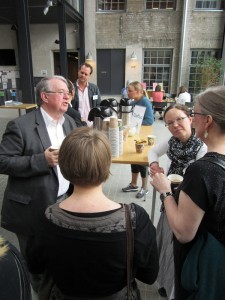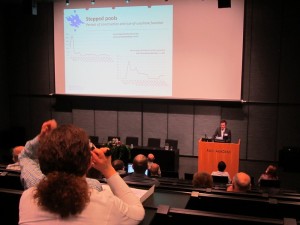by Jutta Jokiranta
Several CSTT members participated in the Third Colloquium of the Finnish Institute in the Middle East (FIME), titled ”Concord, Conflict and Co-existence: Religion and Society in the Middle East and North Africa,” 5–7 June, 2014 in Turku, Finland.
FIME is an important collaborator to CSTT: It supports research visits, organizes conferences and courses, and advances interaction between researchers, institutions and universities relating to the Middle East. (For FIME, see the Annual Report 2013 and the website.)
The colloquium in Turku gathered over a hundred scholars of the Middle East, studying mostly contemporary issues, but also historians of religion and archaeologists who work in the two Centres of Excellence at the Faculty of Theology, University of Helsinki – that is, our CoE CSTT, and the other CoE Reason and Religious Recognition and their Team 1 ”Christianity, Judaism, and Greco-Roman Thought”.

One of the keynote speakers, Prof. Philip Alexander (University of Manchester), presented fascinating textual examples from Jewish sources about responses to Christianity under three categories: 1) counter-exegesis, 2) counter-narrative, and 3) counter-propositional arguments. Similar examples could easily be found in the sources of the Christian side. (Watch Prof. Alexander’s keynote The Jewish-Christian Controversy in Late Antiquity: Counter-Exegesis and Counter-Narrative as Polemical Strategies)
CSTT organized a special session on the theme of Ethnicity in the Biblical World.
Martti Nissinen first defined our task: we approach the ancient Levant already from a narrowly defined perspective, often entitled the ”Biblical World”. This itself is an ethnocentric concept, since we are most interested in only certain texts and peoples of this area. We study texts that are myths and narratives about ethnic groups presenting themselves as distinct entities (Israel/Yehud/Judaeans vs. others). However, the source texts themselves do not carry any independent agency, and thus the management, manipulation, and implementation of this ethnic narrative become the objects of study. Furthermore, not only myths and memories play a role, but also demographic conditions serve as a basis for constructing ethnicities. Changes in demographic conditions need to be taken into account in explaining ethnicities in various locations and periods.
The session included five papers – here summarized by these central claims:
Ethnicities cannot be identified from archaeological evidence!
- Raz Kletter (Team 1) argued that archaeology alone cannot yield any firm evidence on distinct material culture of ethnic groups such as Israelites, Ammonites, Philistines, Canaanites. Instead, textual evidence is needed in order to identify ethnic entities, which themselves are always imagined communities. Ethnicity is constructed through shared myths, memories, and associations – socially held beliefs and emotions, not objects or material traits.
The Persion period Yehud did not renounce figurines as defying ”monotheism”
- Izaak J. de Hulster (Team 1) tackled the claim that the breakthrough of monotheism is visible in the absence or radical decline in the number of figurines found in the Achaemenid period Yehud. De Hulster calls this view the “myth of the reborn nation”: an idea present in biblical texts and in modern day scholarship, assuming that the establishment of monotheism is linked with ‘Israel’s’ return from exile and the absence of figurines in Yehud.Yet figurines did exist also in this period in Yehud. This does not match with the perception of a ‘national’ turn to monotheism. Theoretically, the problem could be solved by a reinterpretation of figurines as non-cultic objects, or by a redefinition of monotheism as allowing inclusion of cultic figurines. Given the scholarly consensus against the two options, de Hulster discussed a third option: identification of the returnees from exile as a ‘monotheistic people’ contrasted with the people who had remained in the land. He applied various approaches to ethnicity and identity to show how the returnee community maintained the “myth of the reborn nation” to define its (religious) identity and even its ethnicity. The myth employs the wording ‘reborn nation’ (not only ‘reborn people’) to indicate the returnees’ exclusive claim on the land (thus embodying what could be expressed anachronistically by the idea of a nation state).
The ’strangers’ could be fitted in the Qumran movement, even if they are not understood as ’proselytes’, since the movement was hierarchical and diffuse
- Jutta Jokiranta (Team 4) asked if there was room for the strangers (gerim) in the ”Qumran movement”. The ger defies strict ethnic categorizations: these were people partly integrated in the activities of the major ethnic group but yet somehow distinguishable. In the Hebrew Bible legislation, the ger changes from being an object of protection to a subject with some religious obligations. Yet the ger is not a ‘proselyte, convert’ in the later sense, not even in the Dead Sea Scrolls. The scrolls present conflicting views on the inclusion or exclusion of the ger, but Jokiranta argued that a too monolithic picture of movement should be avoided. The movement had hierarchical structures that allowed partial integration, and the matter should beconceptualized as one of loyalty, identity and obligations, rather than conversion.
Archaeological remains by no means unambiguously testify to ”common Judaism” in Galilee
-

Presentation by Rick Bonnie. (Photo: Pekka Lindqvist) Rick Bonnie (Team 4) answered the question ”What does ’Jewish’ mean in Galilee inthe second century CE?” from an archaeological point of view. In the traditional narrative, the period succeeding the Temple’s destruction in 70 CE was characterized by a quick rise to power of the rabbinic movement. This is now questioned, but instead certain biblically-derived notions of Judaism (most notably purity issues) are thought to have been widely influential in the Galilean society, testified by archaeological evidence (miqva’ot, stone vessels, synagogues). No systematic study of this archaeological evidence has, however, been carried out,and studies have largely relied on distorted maps of distribution or implied – but not verified – datings of the material evidence. Bonnie presented some of the results of his recent PhD dissertation.
Rich evidence exist of forms of co-existence and interaction between Jews and Christians in the Byzantine period
- Ulla Tervahauta represented Team 4 and Horvat Kur/Kinneret Regional Project. She noted that the co-existence of Jews and Christians in the same Galilean villages in the Byzantine period is in several cases confirmed, and can for the most be assumed. The forms of these relations and interactions need to be studied further,both from the textual sources and archaeological remains. The relations were closer and more nebulous than what early Christian or Jewish writers, the “Church Fathers” and the Rabbis, wanted to admit. The recently excavated byzantine-period synagogue in Horvat Kur is close to Tabgha and its fifth-century church, and in Capernaum a church and a synagogue stand next to each other. Occasionally literary sources too witness co-existence. Tervahauta discussed the hagiographical stories by John Moschus from the viewpoints of concord and co-existence.
Participants of the meeting also saw the preview of the documentary film about the Bedouins of the Jordan valley, Kings of the Desert: Where would we go from here? by Heli Pekkonen and Lea Pakkanen.
Interaction between ancient historians and scholars and institutions interested in present-day issues with regard to the Middle East is important. To listen to the presentations of contemporary issues can be disturbing, eye-opening, inspiring. We are not here to study the history and pretend this is all what matters/ed. Historians and archaeologists need to be aware of the implications their own research of past societies can have on contemporary issues and political debates. At the same time, scholars of ancient Middle Eastern societies can contribute enormously for the better understanding of the roots and emergence of present situation in all its variety.
